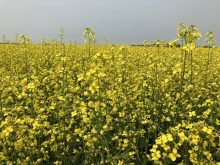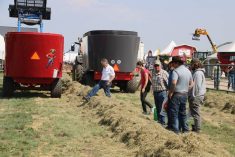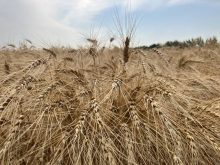The adage rain makes grain is an apt guide when assessing oilseed market prospects for the coming year, says Dave Reimann, market analyst with Benson Quinn.
He told the Saskatchewan Canola Growers annual meeting last week that canola acreage and prices in 2003 will be determined largely by rain, or the lack of it, in Canada, South America and the United States.
Some analysts are making early predictions of a 25 percent increase in prairie canola this year due to strong prices, but Reimann isn’t so sure.
Read Also

Supreme Court gives thumbs-up emoji case the thumbs down
Saskatchewan farmer wanted to appeal the court decision that a thumbs-up emoji served as a signature to a grain delivery contract.
“Right now in my own head I’m thinking it is more like a 10 percent increase, but there are a lot of people calling for 25 percent.”
Expected returns from competing crops such as barley and several pulse and special crops also look good, he said. “I’m quite sure we will see an increase in canola, but it is going to depend on what happens in these other markets. Also it may come down to rain.”
A dry spring will likely cause producers to stick with cereals, while rain will generate more canola acres.
The sharp runup in canola prices this year was caused largely by the drought on the western Prairies. But drought in Australia that slashed canola production there also helped, as did a slowdown in palm oil production growth.
Canola and palm have a higher oil content than soybeans and so the value of the oil component of the oilseed complex has risen higher than the meal component, he said.
The canola acreage and market outlook this spring will be influenced strongly by South American weather.
Brazil and Argentina have record-sized soybean crops in the fields, which for the first time surpass the acreage of the American soybean crop.
Moisture is good throughout Brazil’s soybean areas. In fact, it’s a little too wet in the south where disease might become a concern.
“We are facing some key times for the South American (soy)bean crop,” he said, adding that pods will soon be filling.
South America’s rapid increase in soy production has been mostly offset by rising oilseed demand. China in particular has increased soybean imports as the government there invested heavily in the oilseed crushing sector, pushing its capacity beyond domestic production capacity.
Historically, canola and other oilseed prices drift lower in mid- to late-winter and start to climb in March when production problems might turn up in South America and traders start to focus on potential spring seeding conditions in North America.
Clearly, it remains dry over a large part of the Canadian Prairies and concerns are growing about lack of rain and snow in large parts of the U.S. central plains.
A U.S. Department of Agriculture report late last week found more soybeans in storage than expected. This drove down the price of oilseeds, but Reimann thinks there is a possibility for Winnipeg canola futures to climb back to the $440-$450 per tonne level if problems develop in South America and it remains dry on the Canadian Prairies and the U.S. soybean area.
Such a rally would be a good time to sell old crop and pre-price some of the 2003 canola crop, he said.
“I realize that after this year not many people are going to be interested in new crop pricing, but it is something to keep in mind,” he said.
The downside risk is that South America will get a good crop and rain will return to the Prairies, the U.S. central plains and Australia, and there will be a rapid resumption of oilseed production.
“It comes down to: Does it rain this year? If it doesn’t rain we will probably hold these highs and maybe move a bit higher.
“But if it suddenly starts to rain in the third week of May there is a lot of risk.”
To address that risk, producers might consider buying put options to provide insurance against a price collapse.
“If it doesn’t rain and the market continues to go straight up, you will lose the premium on the put option. But it is like house insurance … if it doesn’t burn down, I’m quite happy.
“In case it does rain, that put option could kick in and possibly save a lot of revenue for you.”

















